marqueta.org
You can't always apt-get what you want
Infosec - Cycling - Estudiantes
RHCE / RHCSA
Once a sysadmin, always a sysadmin
Day 6: from La Portela de Valcarce to Portomarín
May 29, 2024
Rock and Roll, pizza and… churros.
Yes: David, the old rock star, makes churros for breakfast. I decline the offer, excusing myself that I like them too much and if I start, I won’t stop (and it is true!). And that I have to climb O Cebreiro and, with a bunch of churros in my stomach, things will get even more complicated.
Nevertheless he asks me to give him my honest opinion as a Spaniard; the old man from Zimbabwe offers me a generous portion and I try the churros. The truth is that they are not the usual churros, but they are very creamy and not greasy at all. I give my most honest approval to David, who is very grateful.
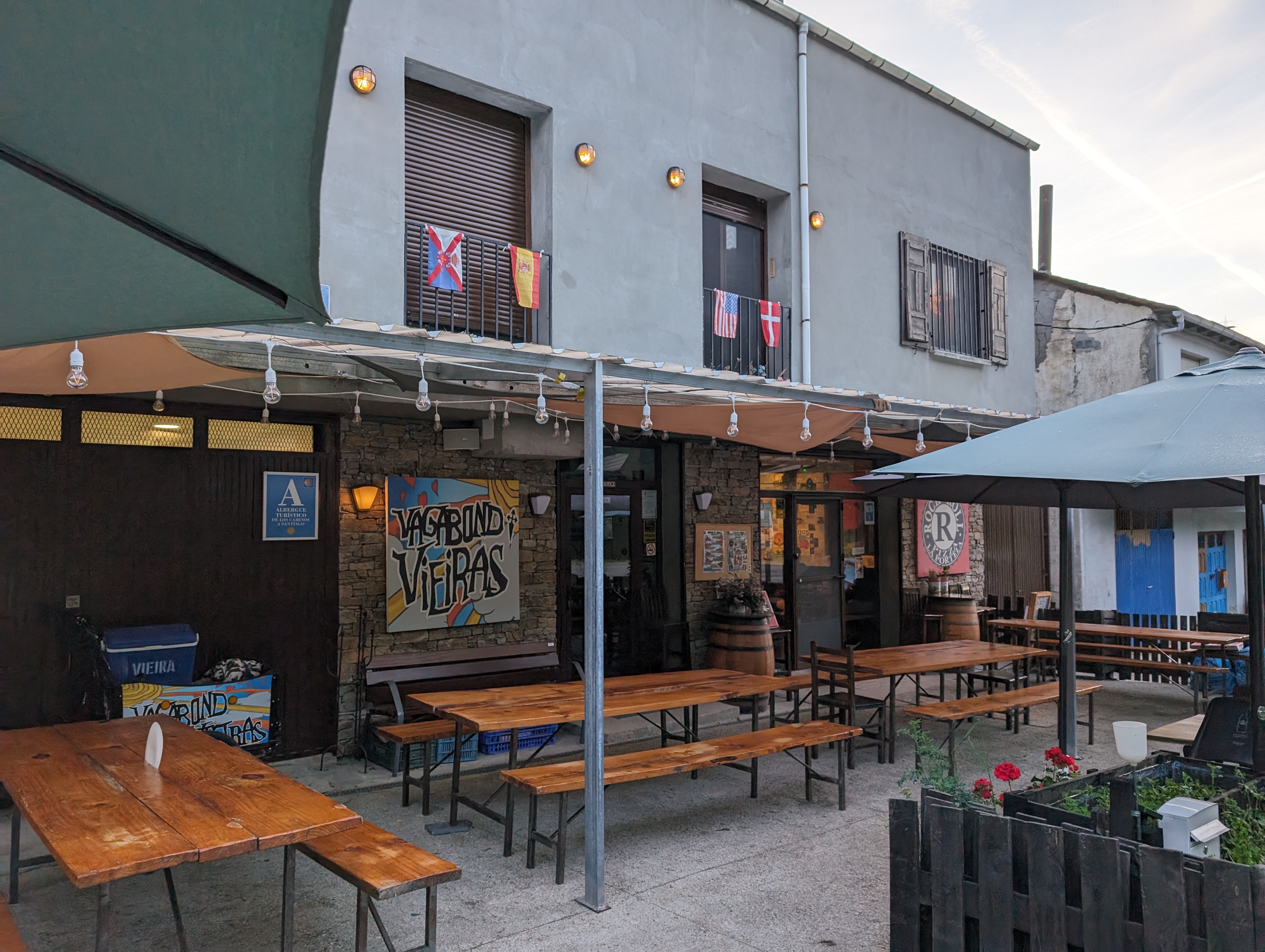
Albergue Vagabond Vieiras
His partner - I don’t know if I ever got her name - had already taken the bike out of the garage, so I just had to pack my belongings and get going.
Before we said goodbye, we had a photo session with David; it’s not every day you get to stay with a rock star!

With David, under the watchful eye of Jerry Garcia.
It’s 7:45 and today it’s time to climb O Cebreiro, the hardest pass of the French Way, at least for those who haven’t had to cross the Pyrenees. My plan is perfectly clear: climb as slowly as I can 😁 But I still have to ride more than 5 km of a false flat, passing Vega de Valcarce and Ruitelán, until Las Herrerías. There we take a detour to the left; you can’t miss it because you’ll be facing a denied entry sign with an additional sign that says ‘no bicycles’. By the way, I don’t know how old it is because until not so long ago it was possible to cycle up the N-VI.
There is still a kilometre and a half of peacefulness as I cross Las Herrerías; I ride along a narrow local road that, still on a false flat, takes me to the neighbourhood of O Hospital, where you can still see many pilgrims getting ready to start the day’s journey.
The morning is cool but, with the knowledge of what is to come, I take a moment off the road to take off my jacket because I know that, in a few minutes, I will be wearing more than enough.
Half an hour has passed and I’ve covered 7 kilometres; on a right-hand turn I see a small bridge that crosses what I think is the nascent Valcarce river and which I quickly identify: I know that this is where the climb begins. It’s about 8 kilometres at an average of 8%, with a slightly gentler section as we pass through La Laguna (the only town we pass through before reaching Cebreiro) and many, many ramps of over 10%.

A flood of pilgrims
A large group of pilgrims occupies the entire width of the road. Following my habit, I keep up with them and try to make myself heard before overtaking them; I go so slowly that I have time to chat and laugh with them before leaving them behind.
The first kilometre (8%) goes by more or less quickly; there, the pilgrims on foot turn off onto a small path that is very difficult to cycle, so it is recommended that the bikes continue along the narrow CV-125 road, on which I see no traffic other than the bicigrinos and a few vans carrying backpacks ( driving, by the way, much faster than they should).
At that precise moment I was overtaken by a group of mountain bikes and I felt envious of their huge sprockets. They’re not carrying any load, but that doesn’t make me envious; I’m quite happy to carry my own stuff and I wouldn’t consider doing it any other way. I can see them moving away very slowly during the second kilometre (7% average), but I know I’ll catch them.
The third kilometre is already harder; the average climbs to 9%, but it has one of the worst parts of the climb. Halfway through this kilometre, there is a fork; continuing straight on leads to La Faba but we (the cyclists) have to make an almost 180º turn after which we face some steep ramps that reach 16% at the worst points.
The next kilometre is the one with the steepest average gradient (around 11%) and it’s also the typical straight stretch where you don’t seem to be making any progress.I remember the advice of my colleague Emmanouil, an expert in long bike rides: “slow is steady, steady is fast ’. And I seem to hear him singing like Dory from Finding Nemo: “juuust keeeep swimming, juuust keeeeep swimming…”. And I keep swimming another hard kilometre (the fifth, again at 9%) until I reach a big turn where the slope softens and lets me enjoy the wonderful scenery that was practically unknown to me, as the bad weather didn’t let me see much in the fog in my previous Camino.
Another switchback takes me to La Laguna, which I pass without stopping. On the way out comes another of the worst moments, as the steepness of the slope is compounded by the poor state of the ground; fortunately I pass it without any problems (another kilometre at 9%) and I know that I’m only a few hundred metres away from the top of the hill. At some point during this stretch I entered Galicia.
I remember that, on my previous trip, I found myself in Cebreiro without the fog letting me even realise that I had reached the top of the pass. This time it was very different and I could stop at the top to enjoy the amazing views:
There was still the little group of mountain bikers that had passed me, taking the typical summit photos. I would meet them again.
As for me, I stopped for breakfast in Cebreiro for a coffee and some delicious and oversized toasts with butter and jam.
But I’m already in Galicia and here bread is delicious, I think I could feed myself with just that 😄
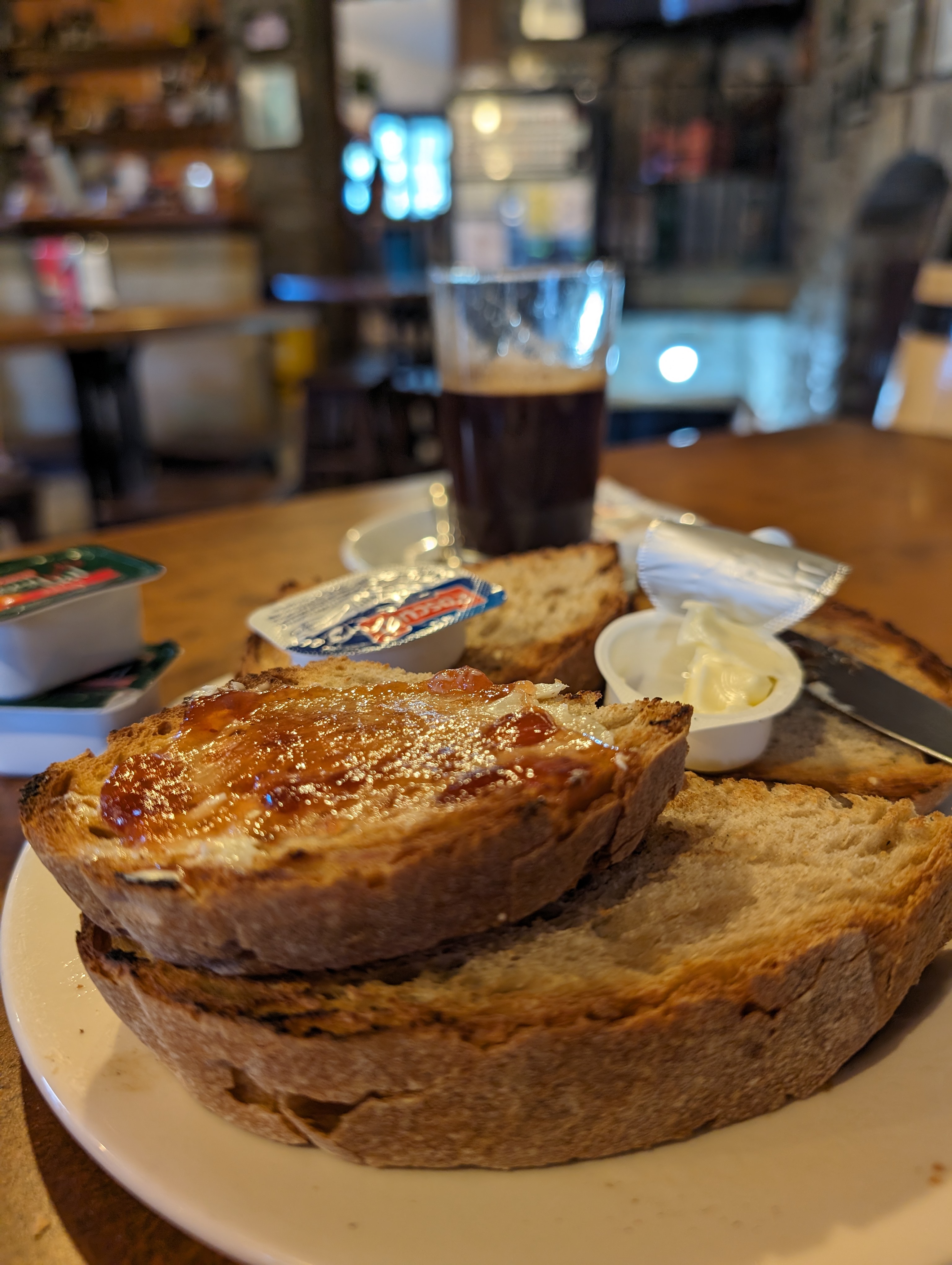
Oversized toast in O Cebreiro
After lunch I get ready to continue my journey; O Cebreiro is the first village in Galicia on the French Way, so it is the start of the pilgrimage for many people. I expect to meet many more pilgrims from here on.
On the bike, I am pleased to see that my coward technique of climbing extremely slowly has worked and I don’t have any feeling of heavy legs, as would be expected from the 700 metres of elevation gain that I have climbed in these first 15 kilometres. But beware, there is still a long way to go, it is possible that today’s stage will be close to 2000 metres of elevation gain; and after O Cebreiro, there are two more small mountain passes to climb: San Roque and Poio. But don’t panic, they are actually short climbs (I’d say less than 2km with low percentages) that, after the previous effort, are passed almost inadvertently.
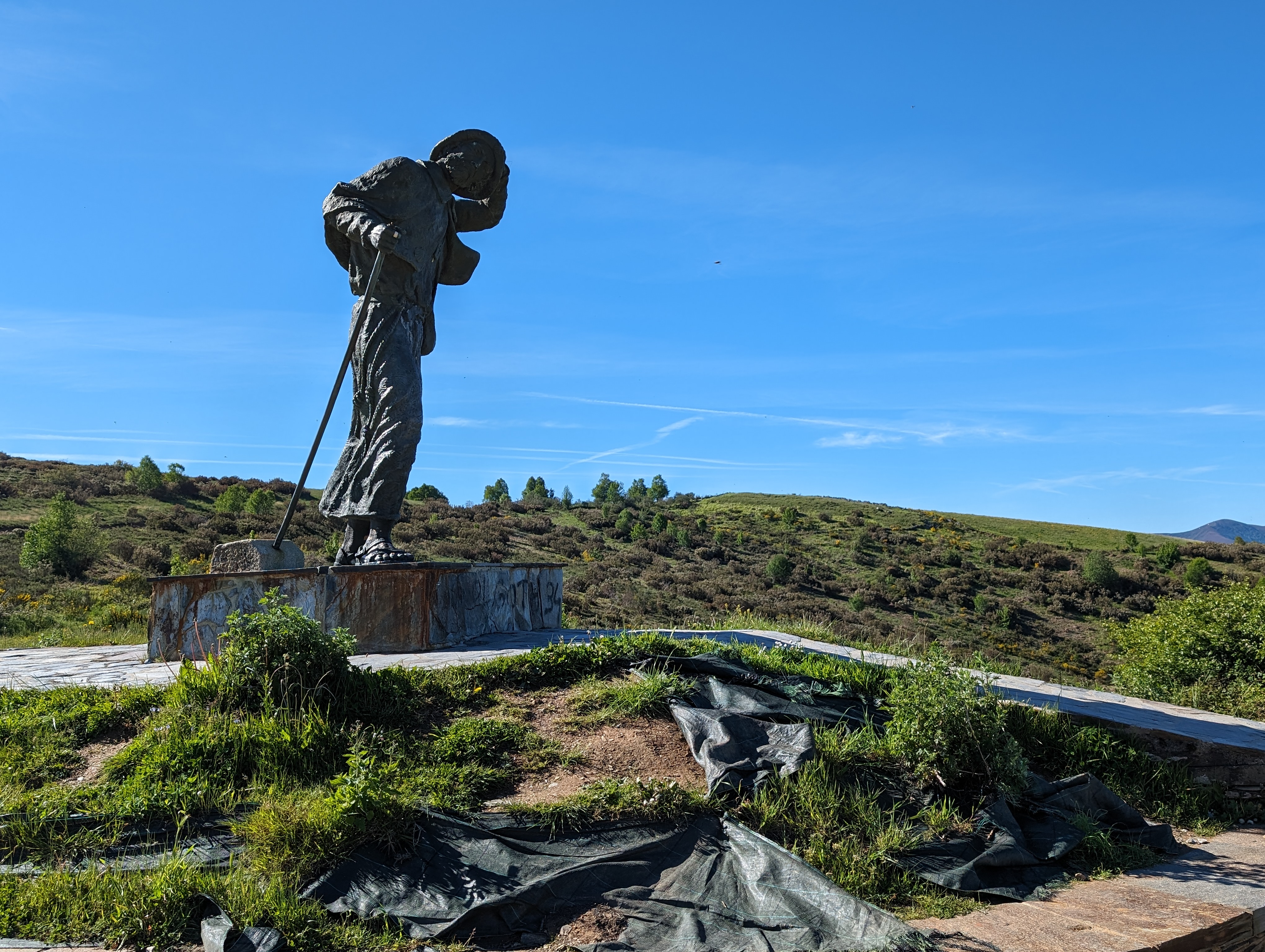
Alto de San Roque
I see the small group of mountain bikers in front of me and I slowly approach them; on this ground (we’re on a wide, quiet road with little traffic and a good hard shoulder), despite the load I carry, my bike is quite faster.
In Poio I catch up with them and we stop to take photos together.

Alto de Poio
We chatted for a while before continuing, and one of them was very optimistic:
— “Great, this is done. From here to Santiago, it’s all downhill,” he said.
— “Well, don’t be so sure,” I replied. “In Galicia, you’ll find very little flat land; it’s a very hilly terrain.”
And it is true; there won’t be any big mountain passes, but it will be a constant up and down, the elevation gain will accumulate, and the legs will suffer.
I say goodbye to the bikers, knowing we would not meet again. I continued a few more kilometers on the road, passed Fonfría, and left the LU-633 at O Biduedo as the Camino diverged slightly from the road and I preferred to follow it. What a great decision! The stretch between O Biduedo and Fillobal is beautiful:
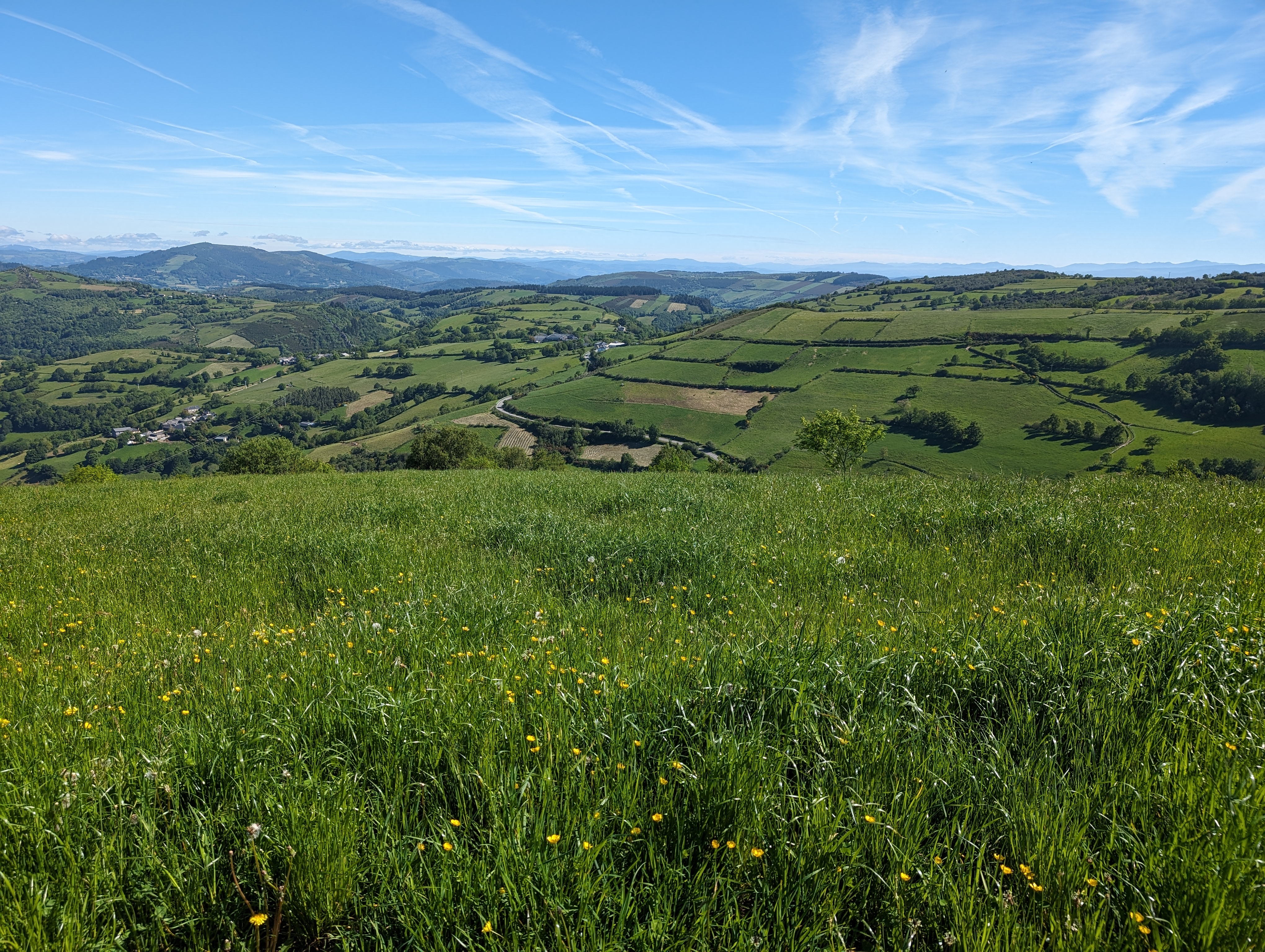
Views near Biduedo
At Fillobal I find myself in a bunch… of cows. At the way out there is a tempting bar with some curious wooden constructions and sculptures, but I only stop to take a few photos.
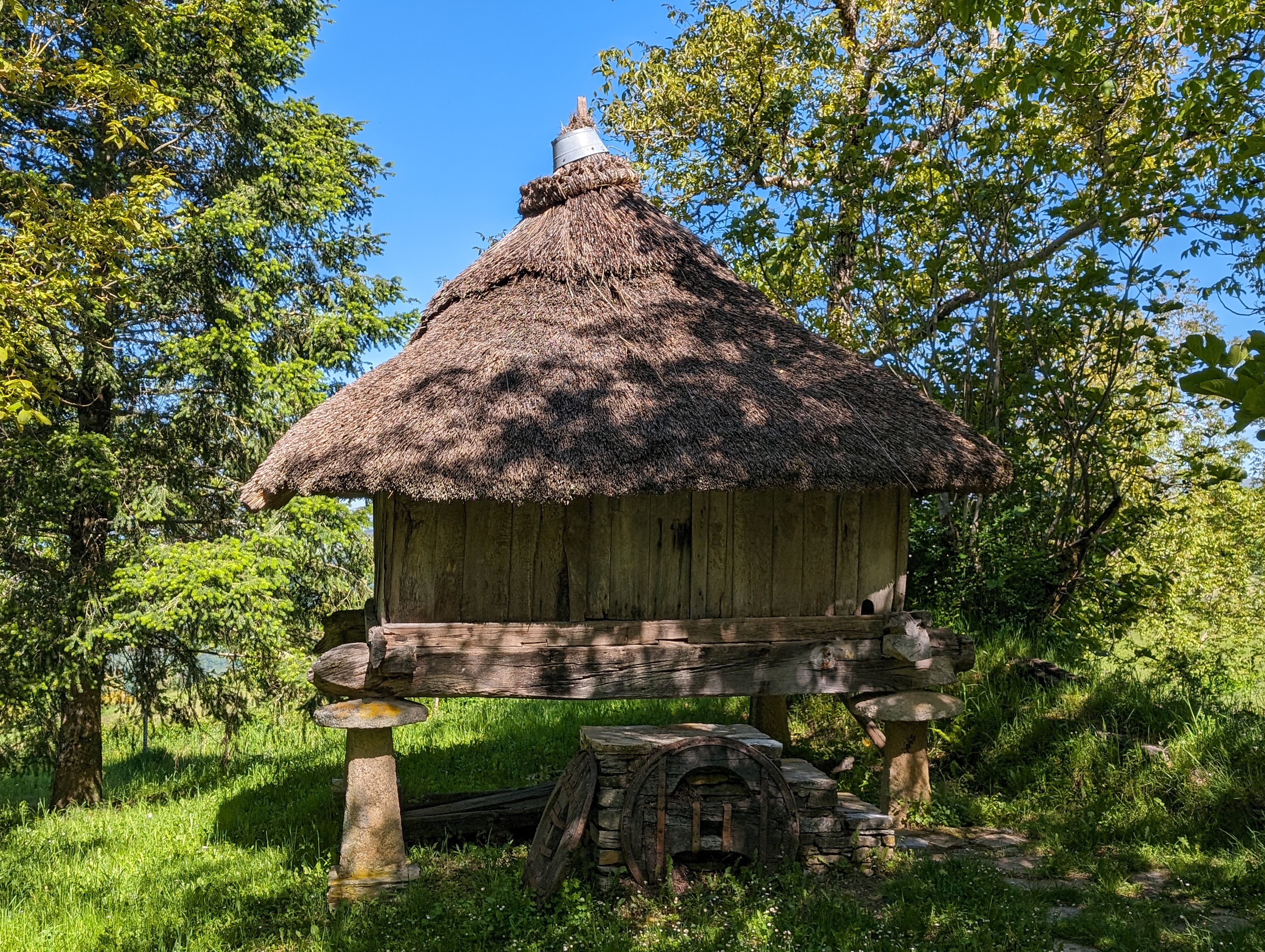
Construction in Fillobal
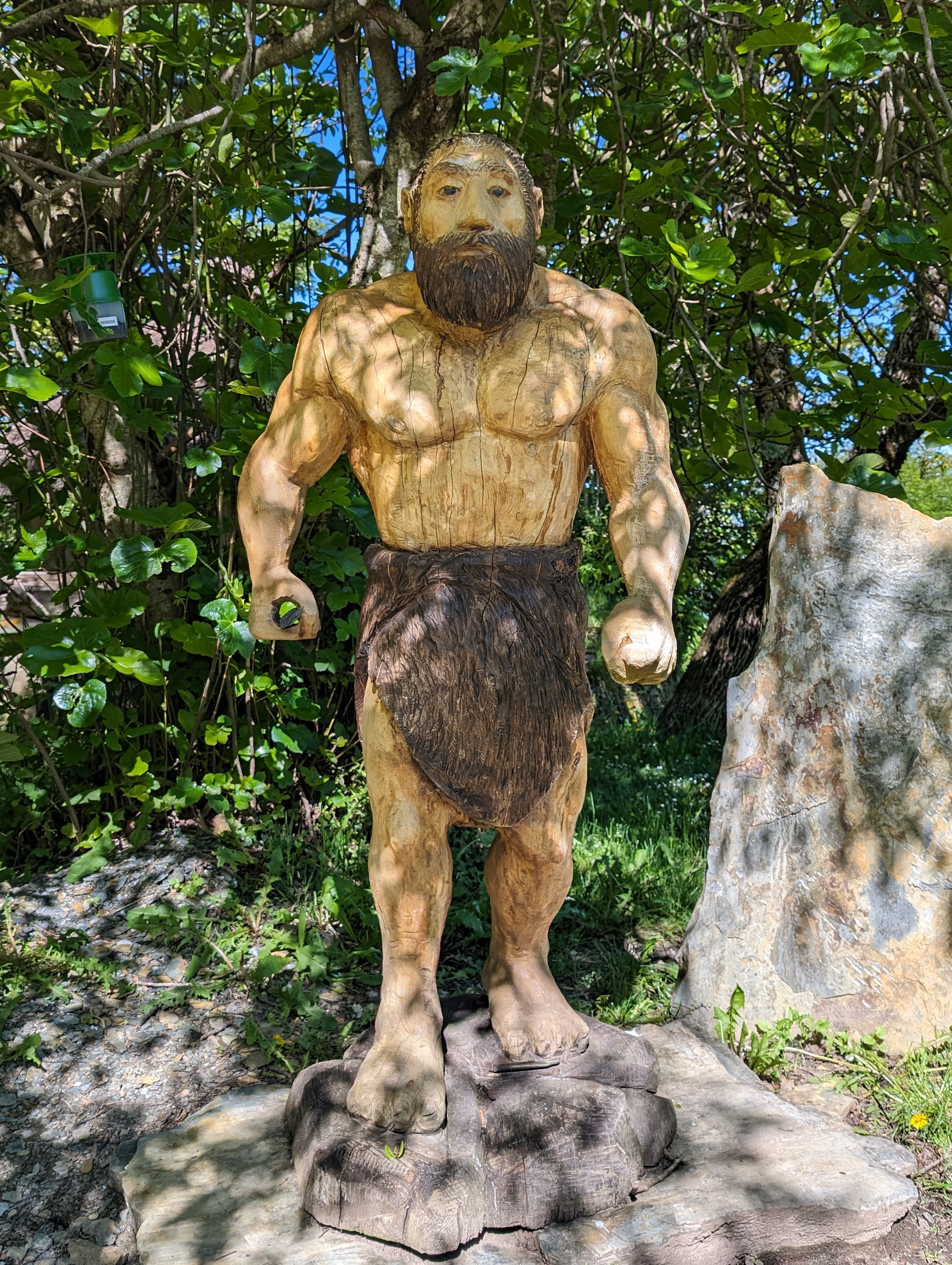
Sculpture in Fillobal
There I join a small tarmac road that soon takes me back to the LU-633, which I follow in fast descent to Triacastela.
I spent the night in Triacastela on my previous trip, so I had time to get to know it well. This time I stop for a cool drink and something to eat, preparing myself for what is to come. Here the road forks:
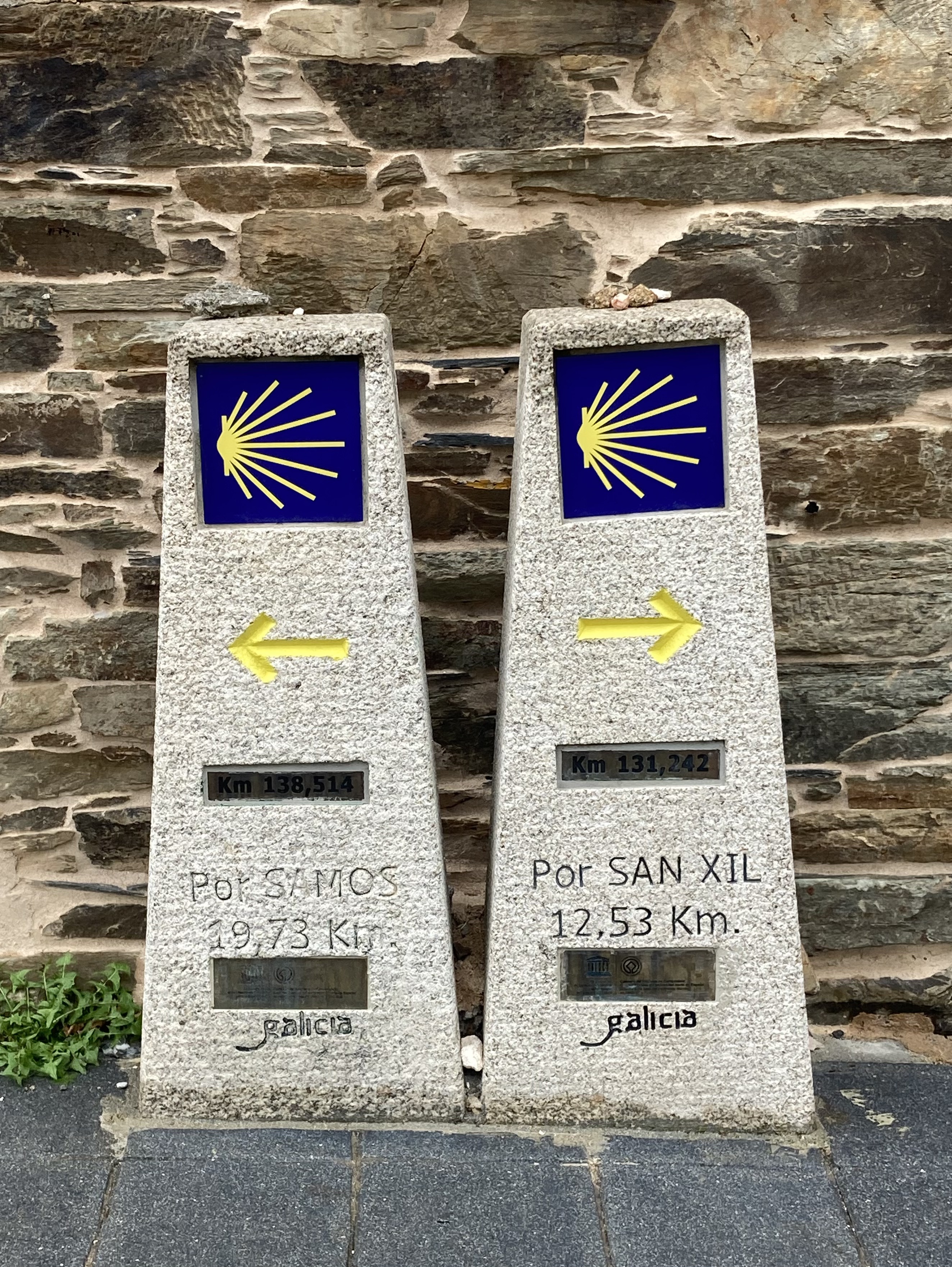
Fork in Triacastela
In 2022 I stayed in a house next to these milestones and I asked my hostess which way to go; she told me that, with the bike, she recommended the Samos variant and I followed her advice, so this year, obviously, I was going to San Xil. As soon as I left the village and took the detour, the Garmin surprised me with an unexpected warning of a steep climb. Maybe I’m wrong, but my memory of the Samos variant is that it was quite easy and flat.

Starting San Xil variant
So I activate the “energy saving mode” - already known from the Cebreiro - and start to climb up a narrow path that takes me to the village of San Pedro de Ermo. At the exit, I am amazed to see a beautiful stone house that is an “Art Gallery”. I hesitate to stop, but today I’ve been going very slowly and I’ve got a long way to go (and apparently much harder than I expected), so with some pain in my heart I pass by.
At A Balsa, another small village, the slope becomes steeper and the trail turns into an unclimbable stone path. I had to push on a steep slope:
Fuertes pendientes hacia San Xil
But the surroundings are stunning and I am very glad I took this variant:
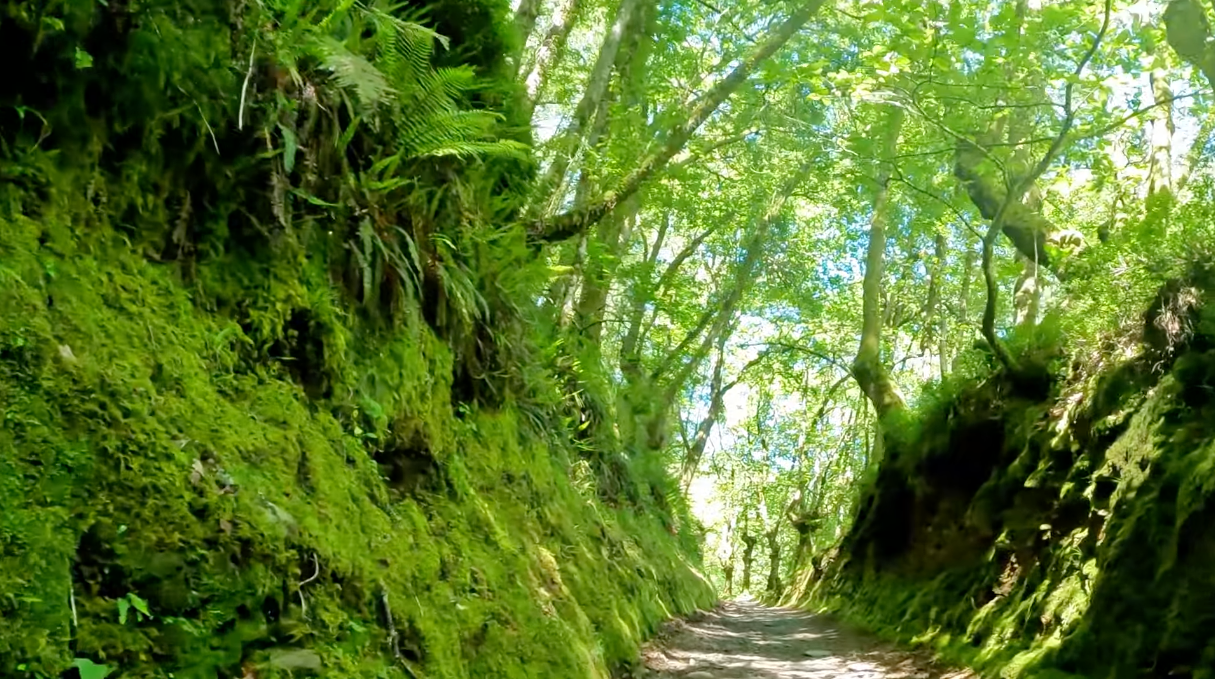
Camino de San Xil
After pushing the bike a few metres, I enter another small tarmac road that, quite possibly, ran parallel to the trail. However, I don’t regret my choice of road. Back on the bike, I continue up to San Xil; I estimate that it has taken me about half an hour from Triacastela.
I imagine that this variant is more popular than the one to Samos because, although it adds some elevation gain, it is a wonderful landscape and it is seven kilometres shorter than the other one, which, walking, is not insignificant.
After San Xil, there is still a stretch of gentle ascent, but the road is very enjoyable. Once in Galicia, the presence of the Eurovelo 3 becomes familiar; in this section it crosses the road and I opt for one or the other as appropriate. In any case, they are almost always very close together.
I skirt several small towns and villages: Montán, Gosende, Zoó, Furela, Aguiada, San Mamade…. Little by little the landscape is no longer so wild, it broadens and shows wider views. A few kilometres of comfortable riding bring me closer to one of the most important towns on the French Way: Sarria.
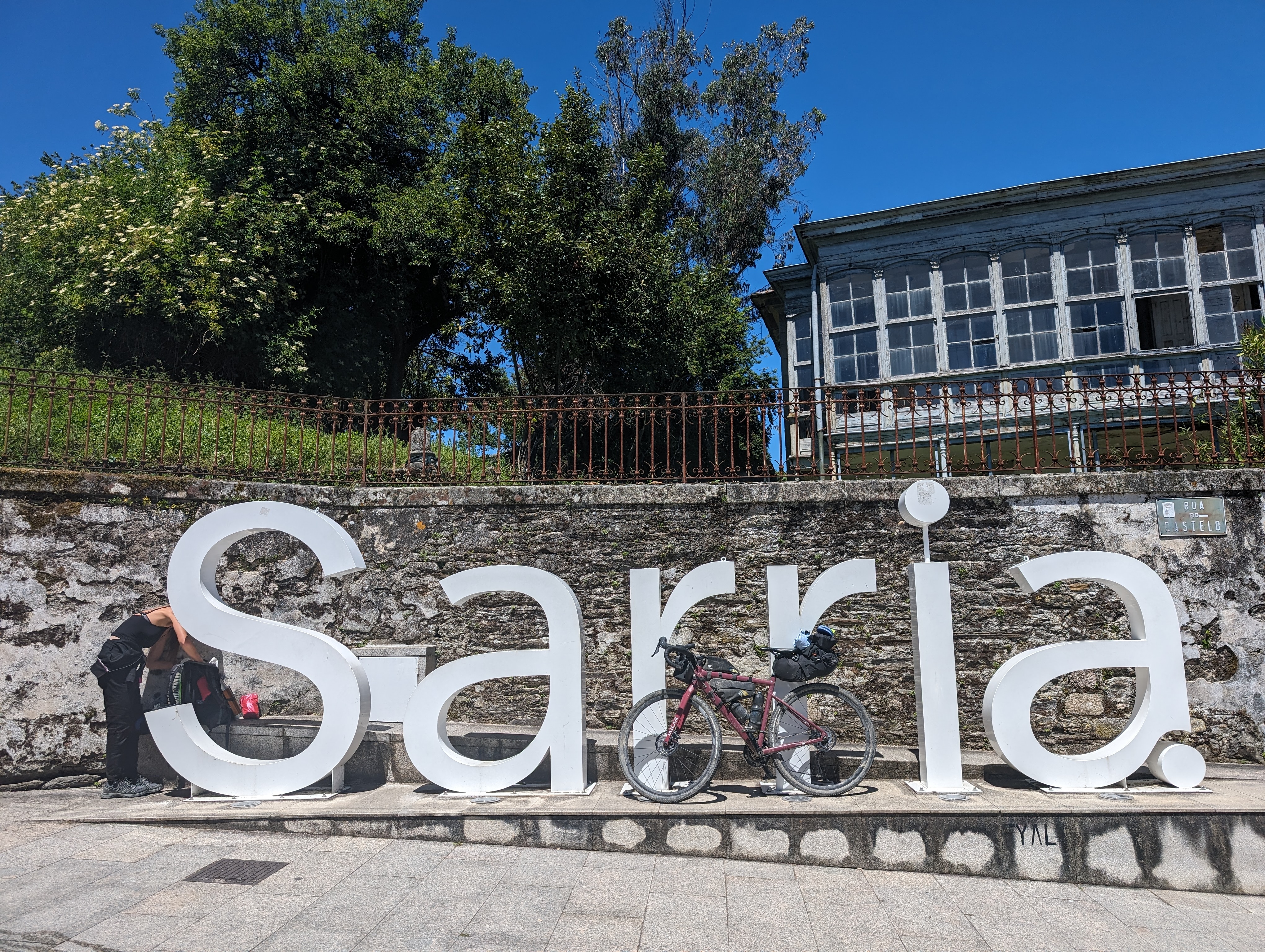
Sarria
And what is the importance of Sarria? Beyond historical, artistic, and cultural considerations, Sarria is the chosen starting point for a huge number of pilgrims for one simple reason: from there, one can complete the 100 kilometers required to obtain the Compostela for pilgrims on foot. It’s worth noting that the requirement increases to 200 kilometers if the journey is made by bike or on horseback (not 100% sure of the latter). In my case, I’ve already covered more than 500 kilometers, so I don’t have to worry about that.
I take a small tour around Sarria while looking for a place to eat, which I find near the Town Hall. I find a spot to leave the bike and sit on the terrace while observing a curious fact:
Indeed, mine is the only human-powered bike; that is, without a motor. It should be noted that the Compostela is not granted to bicigrinos on e-bikes, although I don’t think there has ever been a case of volunteers from the pilgrim’s office in Santiago coming out to inspect the bicycles, as if they were UCI judges. It relies solely on the pilgrim’s honesty to tell the truth.
The pilgrim’s menu consists of some macarrones and roasted ham; it may be a modest menu in terms of quantity and quality, but at that moment, I would have awarded it a few Michelin stars.
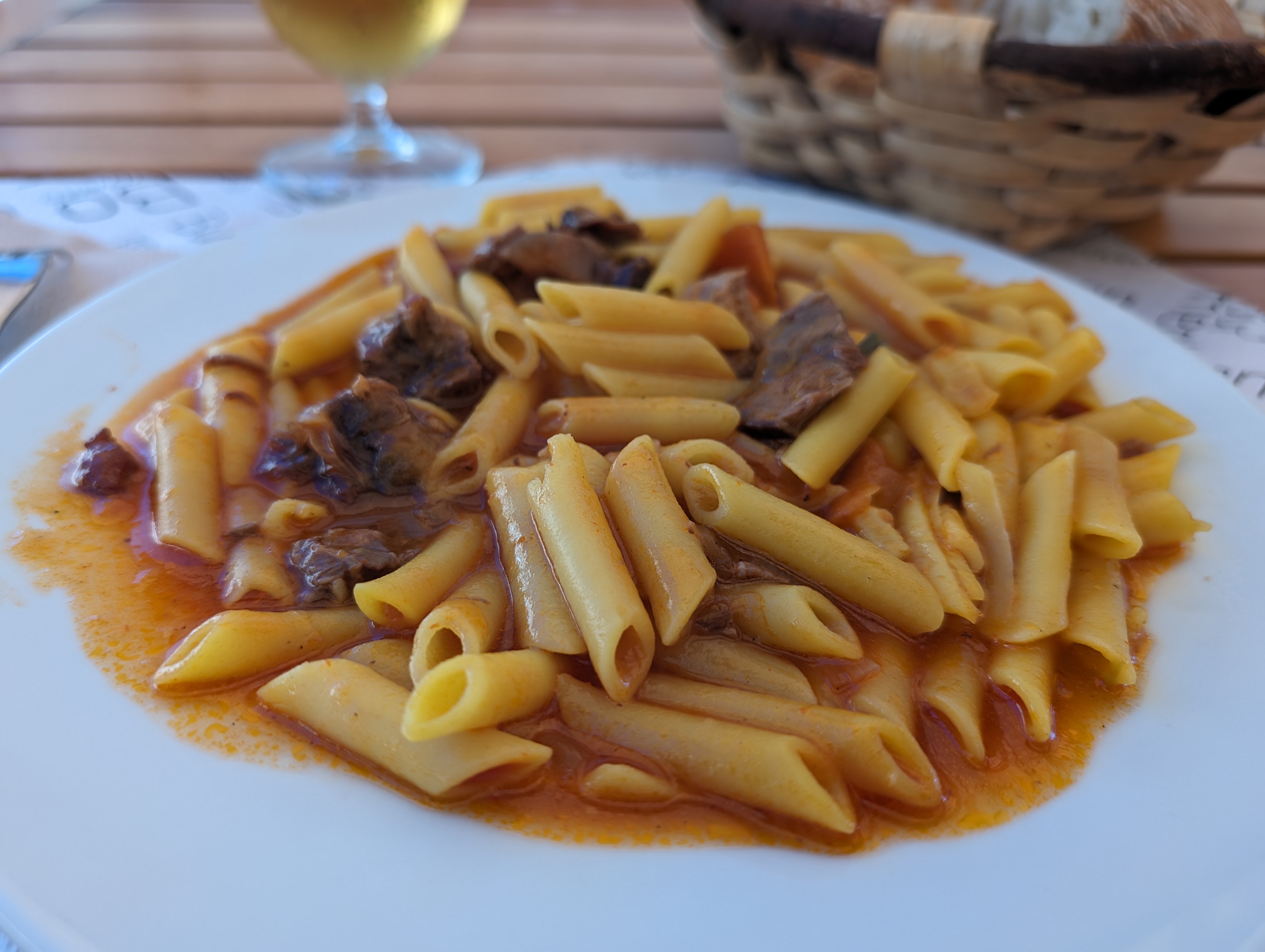
Pilgrim menu
While still sitting at the table, I get a big surprise. A very tall and thin bicigrino passes in front of me, pushing a high-end bike with saddlebags. Indeed, it’s the Belgian cyclist I had been talking to during the ascent to Cruz de Ferro! I am surprised to have arrived here before him, and especially by his tired appearance. He recognized me and greeted me:
— Hey, my friend from Belgium!
— Hi!, glad to see you again, how are you doing?
He was also surprised and said to me, “See? I told you that you would feel better each day…” He ended his stage for the day in Sarria, while I mentioned that I intended to continue for a few more kilometers, so we said our goodbyes. We wouldn’t meet again.
My departure from Sarria in 2022 was quite regrettable; I tried to avoid the traditional path and paid for it by taking an absurd detour, getting lost, and doing a few kilometers back in the direction of… Sarria! So this time I made sure to carefully follow the yellow arrows towards the Monastery of La Magdalena to cross the old Ponte de Áspera. It’s supposedly not recommended for bikes, but I didn’t care, and, in fact, I don’t think I had to get off my bike at any point.

Ponte de Áspera
It’s very hot, and any shade is appreciated; after the bridge, the path offers some shade now and then, although at times I can’t escape the sun’s punishment. I move through small villages, alternating between comfortable tracks, Eurovelo 3, and some stretches of stone paths that are difficult to cycle on.
In the vicinity of one of these villages, A Pena, I realize that I’ve just entered the last 100 kilometers and think that it might be possible to reach Santiago tomorrow, a day earlier than expected. But, I don’t dwell on it too much because so far “the plan is that there is no plan,” and it’s working very well for me.

Less than 100 km to go
In Moimentos, I leave the Eurovelo and return to the trail, descending towards a deep valley where Portomarín can be glimpsed at the bottom. Along the way, I make one last stop for a cool drink and continue among a good number of pilgrims: it’s obvious that there are a lot more after Sarria.
When I crossed the bridge over the Miño in 2022, the river barely had any water, making the view somewhat disappointing. Today, in addition to the beautiful weather, there was a lot of water flowing. I cross the bridge towards the famous staircase leading to Portomarín and sit in its shade for a while to look for accommodation to advance a bit more and ensure my arrival in Santiago the next day. However, I don’t find anything in a quick search of the nearby towns and decide to stay where I am. Once again, the decision proves to be a good one.
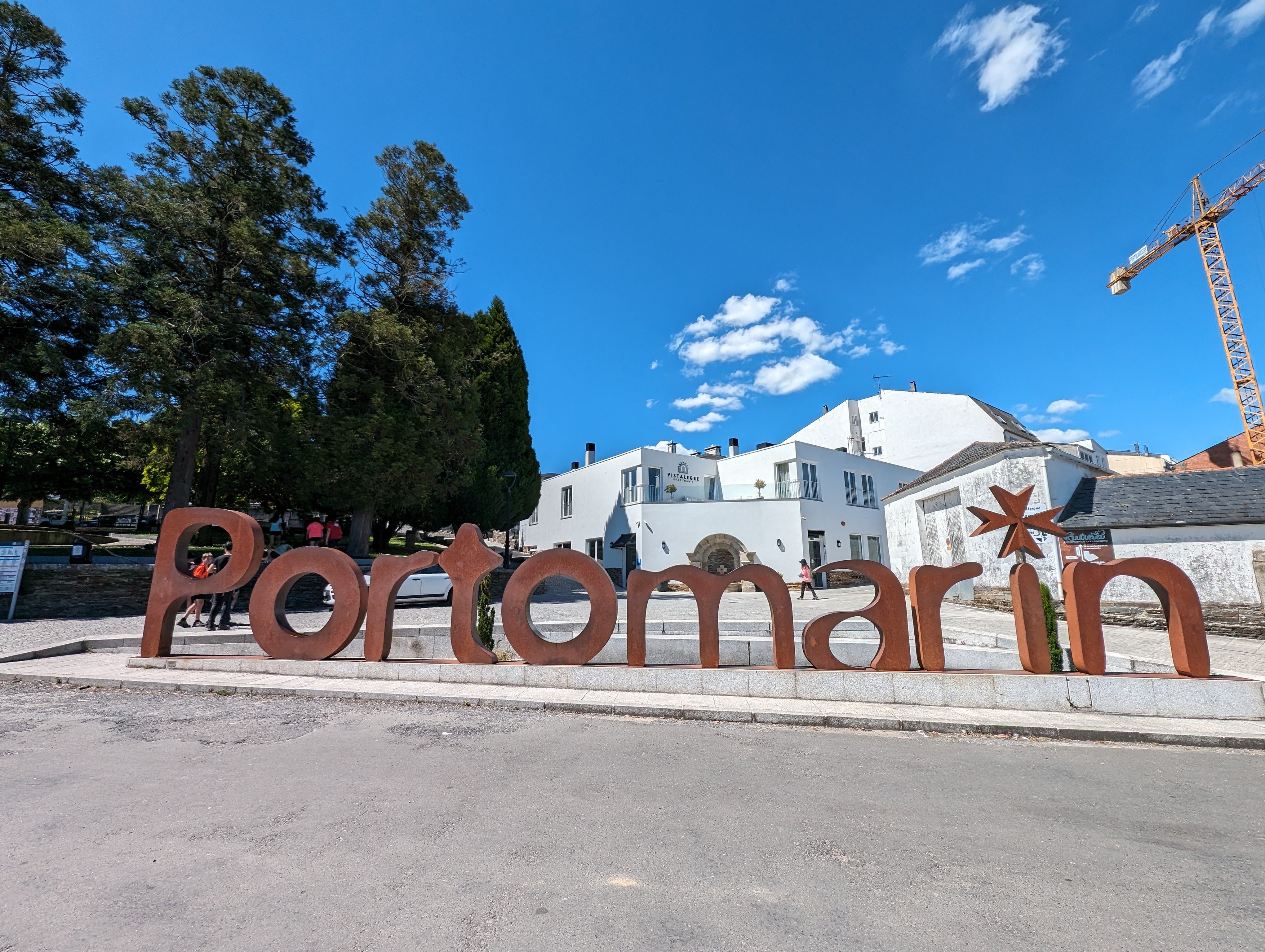
Portomarín
I manage to get a bed at albergue Huellas; the place is fantastic, everything is very new and clean. The price includes bedding and a towel, and I only pay extra for the washer and dryer (which was needed today). I store the bike, take a shower, and get ready to take a walk around the town, as I have plenty of time.
For the first time, I get a bottom bunk in a hostel; but when I go back to the room I see an older woman placing her stuff there. With great tact, I explain to her in English that it’s my bunk, and she responds in very good English that she knows and will move her things to the top bunk immediately. I feel bad, so I offer to switch bunks with her, and her face lights up as she immediately accepts the offer.
Soon after starting the conversation, we realize how ridiculous we’re being because Virginia, as she’s called, is from Venezuela, although she lives in Miami with her daughter. But it’s the habit of not coming across Spanish-speaking pilgrims for days.
With everything more or less organized, I head out for a walk around the town, starting with a large, cold beer (Estrella Galicia, I suppose). Of course, I visit the Church of San Nicolás (also known as San Juan), with its Romanesque fortress-like appearance. Fortunately, in just a few minutes, a concert of flute, harmonium, and Gregorian chant begins.

San Nicolás / San Juan church in Portomarín
The story is well known; the town of Portomarín was going to be flooded by the construction of the Belesar reservoir in 1962, so some of the most important buildings, including the church, were dismantled and moved stone by stone to their current location on Monte do Cristo.
The concert keeps me entertained —and at times, really moved— for almost an hour; I again think of Luis. As I leave, I run into my albergue neighbor and we chat for a while on the way to the hostel; she stays in -planning to get an early start— but I continue my walk, as I’ve earned a small treat in the form of a good dinner today.
The walk leads me to the restaurant O Mirador, well named for its views over the Miño river:
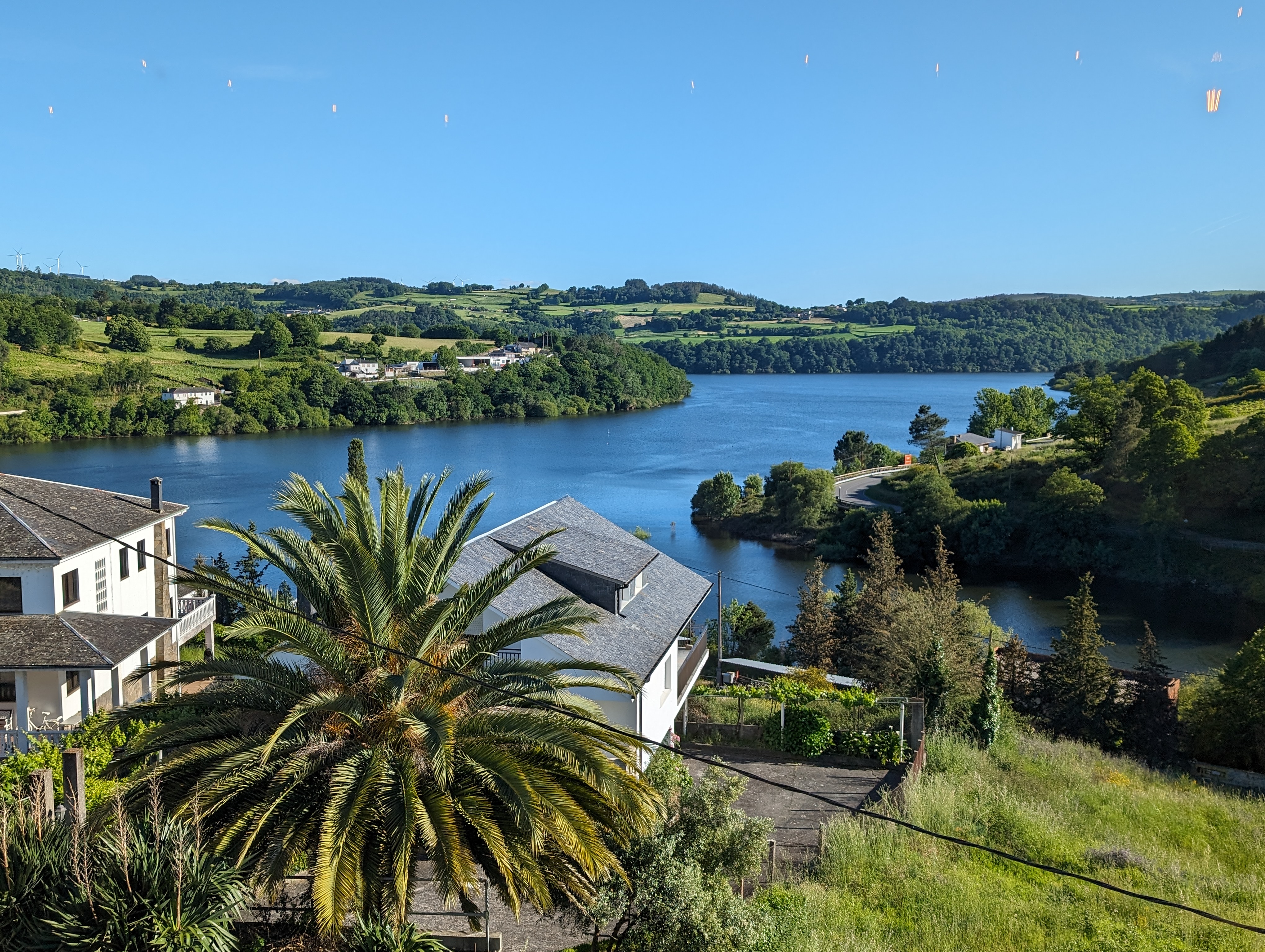
El Mirador
A fruit salad and a serving of pulpo a feira (octopus) accompany the view; and, of course, a glass of Albariño wine. Tomorrow I will likely not stop in Melide (the town where it is typical to have the first octopus of the Camino) at lunchtime, so at least I will have already eaten the mandatory (and very recommended) pulpo.
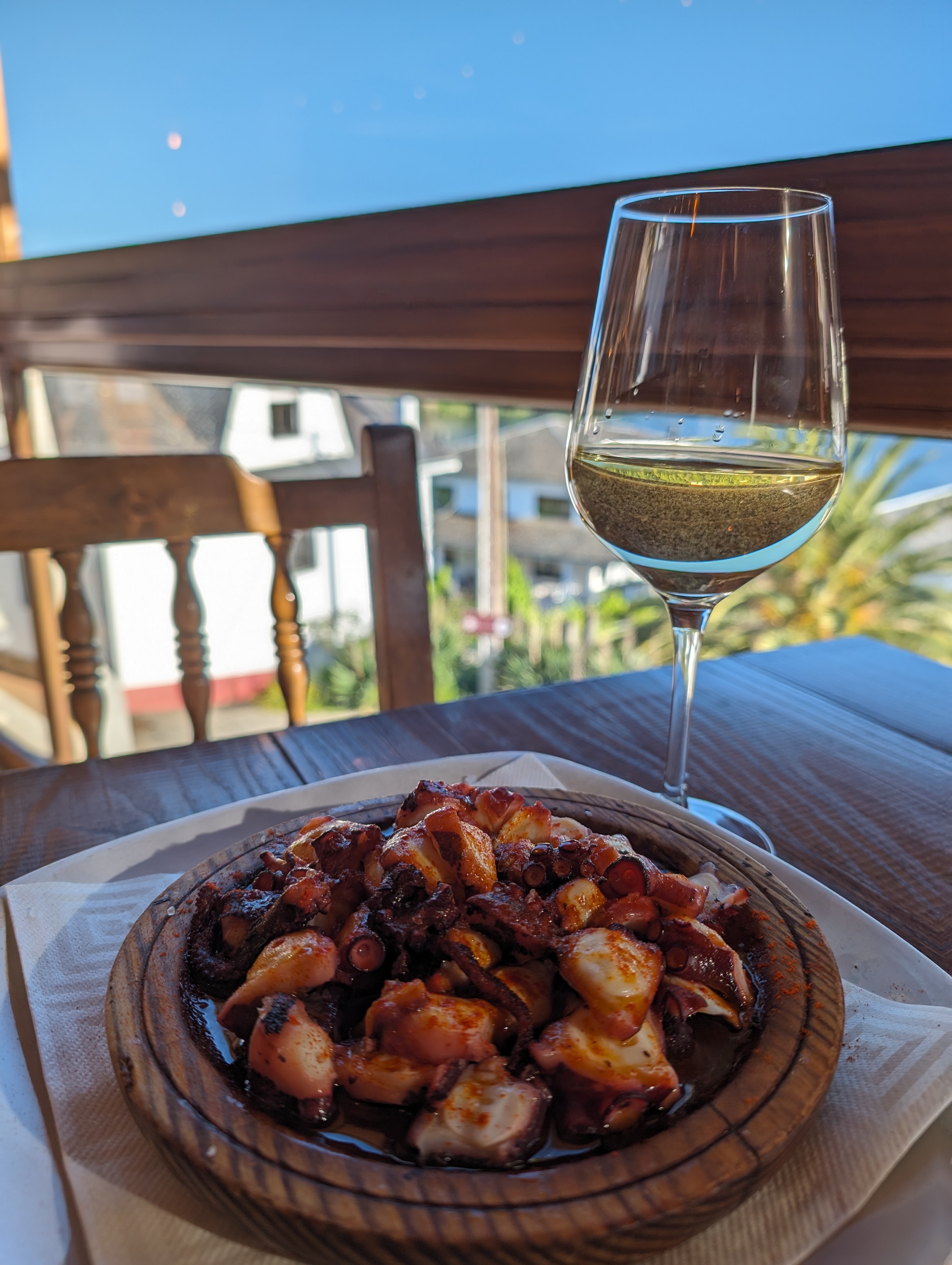
Pulpo a feira
Back at the albergue, it’s too early to go to bed, so I stay for a while in the kitchen/living room writing in my travel journal. However, I barely have a moment of peace as first a Catalan couple who are still having dinner, and later an Irish pilgrim eager to chat, keep me from focusing on my notes.
The Irishman (I don’t remember his name) talked a lot, very fast and very very loud, which made me a bit uncomfortable because I thought he might disturb the lighter sleepers. So, I opted to end the conversation and head to my bunk earlier than I would have liked; before that, the pilgrim gave me a muffin that would come in handy the next day.
The day has been very long and full. Many things, many people, many landscapes have passed. And I’m just over 90 kilometers from Santiago de Compostela. What will happen tomorrow?
Stage Summary
- Distance: 78 kilometers
- Elevation Gain: 1000+ meters
- Time: About 8 hours, including stops
- Track on Komoot
- Track on Wikiloc
Track
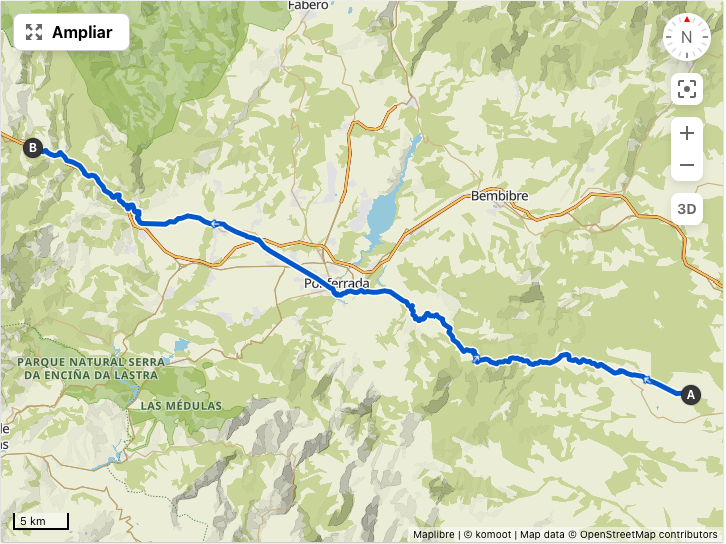
Profile

👈 Day 4: from El Burgo Ranero to El Ganso | Day 6: from Portela to Portomarín 👉
Stage Summary
- Distance: 85 kilometers
- Elevation Gain: 1600+ meters
- Time: About 8 hours, including stops
- Track on Komoot
- Track on Wikiloc
Track
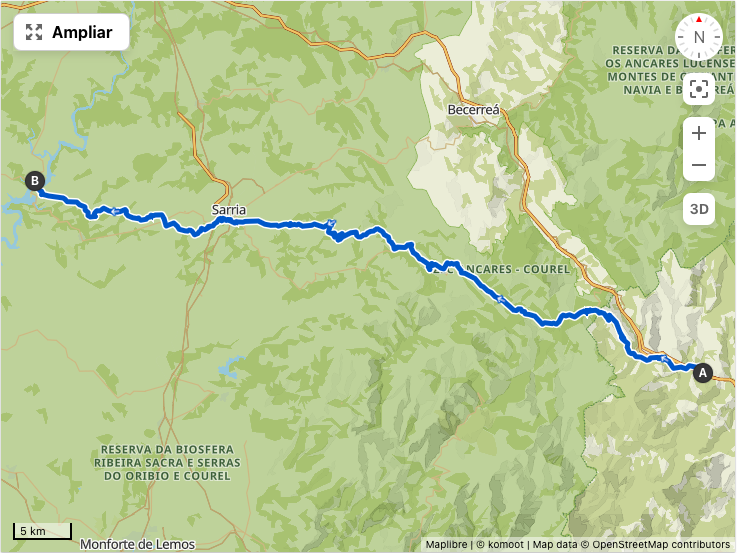
Profile

👈 Day 5: from Maragatería to El Bierzo | Day 7